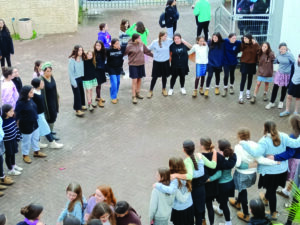The future is near for AMIT students, and Microsoft is helping them get there.
AMIT students from across Israel, including the periphery, recently were chosen to participate in Microsoft Israel’s prestigious leadership program, Teams Leaders, where they learn about using Microsoft’s platform to create more collaborative learning environments.
Only 100 students out of several hundred candidates were tapped to participate in the selective program. The AMIT students hail from schools throughout the nation’s periphery, including: AMIT Hatzor HaGlilit High School; Ulpana AMIT Anna Teich Haifa; AMIT Wasserman High School for Girls Maaleh Adumim; Ulpana AMIT Dyckman Beer Sheva; AMIT Kiryat Malachi High School, Midreshet AMIT Ashdod; AMIT Karmiel High School; AMIT Atidim High School Or Akiva, and AMIT Gutwirth State High School Sderot.
The students will learn to use Microsoft’s Teams platform, which combine workplace chat, video meetings, file storage, and other tools to streamline collaboration. They also get to participate in training sessions at Microsoft’s Ra’anana offices that will equip them to advance computerized education projects at their schools.
AMIT’s STEM-centric curriculum emphasizes science, technology, engineering and mathematics as a way to catapult students into 21st-century careers, including computer technologies, like those at Microsoft. Also, significant, for AMIT students who live in the periphery, they are being exposed to the high-tech world, an opportunity that might otherwise not happen.
The dozens of AMIT students, who were accompanied by the network’s educational technologies consultant, Mireille Surowicz, recently had their first training session at Microsoft.
Following the tour of Microsoft’s innovative business center and an introduction to some of its technologies, the students got a hands-on collaborative experience within a Teams learning environment. Microsoft touts Teams as a tool that allows students, teachers, and faculty to work together, create content, and share resources all from a single-use platform.
It was a good beginning for the students to envision a big and bold future.
Another group of AMIT students recently visited Microsoft. This group came from AMIT Ulpanit for Girls Or Akiva, a junior and senior high school in the country’s north. The students are part of “To Touch the Future,” a special program at the high school introduced last year.
“To Touch the Future” allows these high school students to take online university-level courses as a way to encourage them to seek higher education after they graduate and complete their Sherut Leumi or IDF service.
Among its many missions, AMIT is committed to empowering its female students, especially those on the periphery whose opportunities to higher education and high-level careers may be limited by socioeconomic and geographic factors.
While AMIT Ulpanit for Girls Or Akiva has a higher than national average bagrut – 96 percent – few of its graduates actually seek higher education. The goal of “To Touch the Future” is to coax these students to go on to universities and colleges by demystifying the college experience. So, while still in high school, they take university-level courses online. It is a win-win proposition: the student sees she can master these courses, they gain college credits, and as a result, they envision a new future for themselves.
Among those who attended the recent visit to Microsoft with the “To Touch the Future” students was Randi Garber, the daughter of Judith Garber, z”l, who along with her siblings, dedicated the expanded program at AMIT Ulpanit Or Akiva through a scholarship fund in her mother’s name. The funds not only allow more students to participate in “To Touch the Future,” but also make possible visits to universities and to events such as the one at Microsoft.
Garber wrote about her moving experience with the students. “Today I met the young women participating in the ‘Touch the Future Program’ at the Or Akiva AMIT School and it was I who was touched,” Garber wrote. “In addition to enabling [the students] to get university credits while still in high school, the program seeks to open these young women to professional opportunities and dare them to dream about reaching them.
“After two inspiring talks by young female employees of Microsoft and a taste of the future of technology, the AMIT students took part in a Hackathon. In one of the Microsoft films, a teacher spoke about the spark in his student’s eyes when they take part in Microsoft educational programs. I thought it sounded a bit trite. But sitting there with the ‘our’ students, I saw the spark in their eyes and the dreams begin to form,” she continued.
“I asked a few students what their takeaway from the day was and they said, ‘It helped me believe that I can do it, too.’”
It looks like the students’ future is not only near. The future is now.





